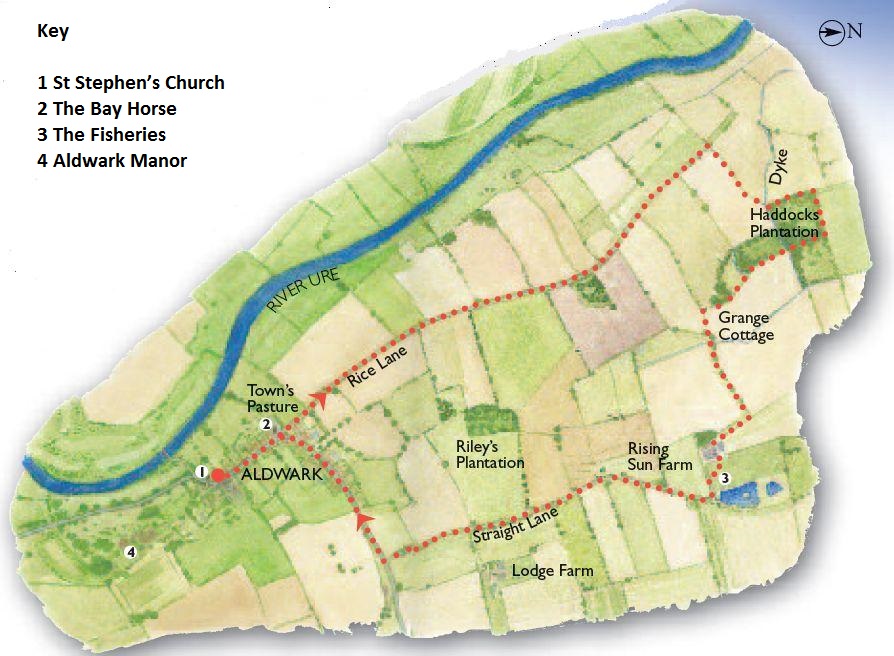Aldwark Ramble

The Aldwark Ramble
This pleasant stroll takes a circular route through cultivated, wildlife-rich countryside under wide open skies. It takes you where witches walked, through the ancient hunting grounds of kings and links in with a man who fought at the Battle of Hastings.
Some say the Saxons named Aldwark as ald weord (old fort) after Roman buildings reputed to have been sited close by. Before or after your walk, it’s worth spending some time at St. Stephen’s Church. It was commissioned in 1852 by Lady Frankland Russell who lived in Aldwark Manor – a building you might wish to see later. As a fascinating information panel in the church details, the designer E. B. Lamb (one of a group of ‘rogue architects’) used a highly original method of design.
Walk Information
The full walk is just under four miles (6km) and should take two hours at a steady pace.A level walk on bridleways and quiet lanes. From the church through the village and up Straight Lane to The Fisheries is suitable for wheelchairs and scooters. Park thoughtfully in Aldwark village. Start at the walk interpretation panel on the grass verge outside the church. Follow the route shown by the brown waymarkers.
OS Map Explorer 299 covers the area.
Buses serve Aldwark (www.northyorkstravel.info)
The Route
From the churchyard, depending on the time of year, you might just glimpse the River Ure, used to transport lead in Roman times and still used to ferry farm produce, lime and coal until well into the last Century. Cargoes could go up river to Ripon and the UreValley and downstream toYork andHull.
Nearby, but not available for public viewing, is the conjuring stone, said to fasten the troubled spirit of a ghost called the Witch of Hollows Hole, ‘doomed for a certain time to walk the night, and for the day confined to fast in fires, till the foul crimes done in his days of nature be burned and purged away’.
Facing the interpretation panel head right to begin your walk with a stroll through the village. This used to be estate land which was sold off in 1911 when Aldwark contained a Manor House, 13 farms and small-holdings, a school with a house and 18 cottages.
In the early morning and evening, barn owls are often spotted around the village. JustpastTheBayHorse pub on your left, go straight ahead ontoRice Lane, a bridleway. Keep an eye out for more wildlife – more than 60 species of birds have been recorded here including red kite.
The bridleway runs for over a mile and then turns right, crosses a dyke and follows the edge of Haddock’s Plantation.Go right along the woodland edge then right again through the plantation.The path passes between Grange Cottage and the outbuildings.
As you join the grassy track heading towards Rising Sun Farm (where roe deer have been seen) you’re treading ground which was once the edge of the ancient Royal Forest of Galtres, used for hunting by kings since Norman times when they stayed inYork. This land used to be dense forest, teeming with deer and wild boar, but HenryVIII had the trees cut down to build his fleet.
As the route continues pastThe Fisheries, used for coarse angling, there’s a chance of spotting waterfowl including mallard,moorhen and Canada goose.
You then head down Straight Lane and back through the village to the church.Opposite is the entrance to the impressive Aldwark Manor, now a country house hotel and golf resort.The Manor was built in the 1860s as a home to the Frankland family, owners of this estate, which can be traced back to
Domesday Book times. And it was the daughter of Henry Frankland of Aldwark who married a descendant of SirWilliam Fitzwilliam -Marshallto the army ofWilliam the Conqueror at the Battle of Hastings.